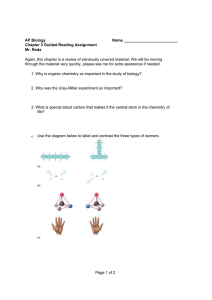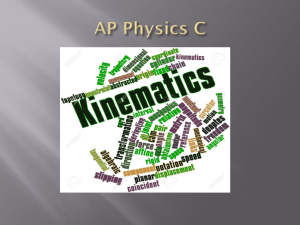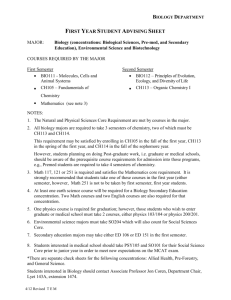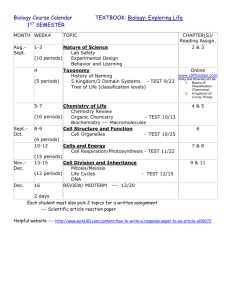Science Classes 1213 - Grayslake North High School
advertisement
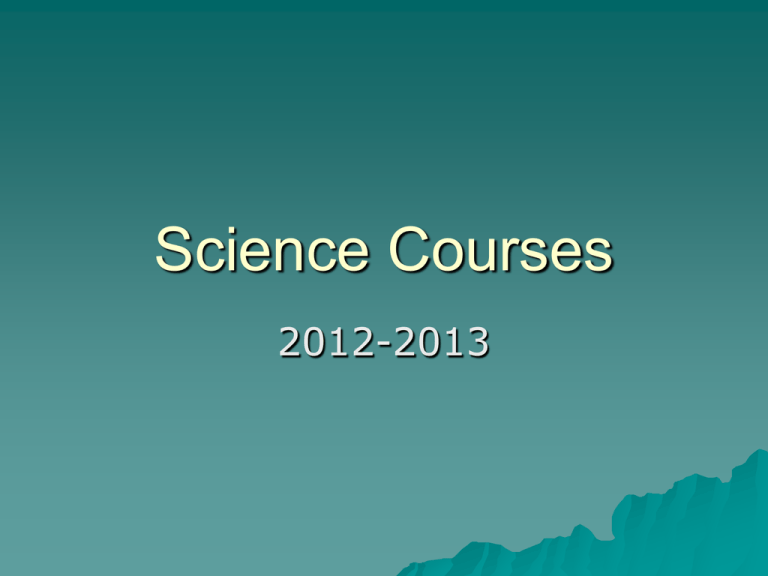
Science Courses 2012-2013 Recommended Science Credits Graduate GNHS – 2 Credits Junior College (CLC) – 3 Credits – 2 Credits Military – 2-3 Credits Big Ten Colleges Ivy League Colleges – 4 Credits Planning to Major in a Science – 4 Credits Local Colleges (NIU, WIU) – 3 Credits Science Course pathways Physical Science Course Description This two semester, lab-oriented course is an overview of the foundations of both Physics and Chemistry Recommendations Passed or Concurrent enrollment in Algebra Physical Science Physics Speed, Acceleration, Forces, Energy, Simple Machines, Rube Goldberg Competition Chemistry Properties of Matter, Physical and Chemical Reactions, Atomic Theory, and an Introduction to Chemical Equations Earth Science • Course Description This two-semester laboratory course focuses on the study of Earth processes, including the areas of geology, meteorology, astronomy, and oceanography. Students will engage in experiments, creating models, simulations, web quests, and other activities. Real-life applications include weather forecasting, construction considerations, local landscapes, exploring current global issues, and more. • Prerequisites – Placement by Recommendation for 10th grade – Offered for 10 – 12th Grade Earth Science • Geology – Rocks, Minerals, Earthquakes, Volcanoes • Oceanography – Currents, Wave Erosion, Tsunamis • Meteorology – Clouds, Wind, Severe Weather, Weather Forecasting, Global Warming • Astronomy – Solar System, Asteroids, Stars, Galaxies, Star Gazing Earth Science Honors • A dual credit course is a college course taken by a high school student for which the student is awarded both college and high school credit. This course is designed for students who are interested in physical features related to our dynamic earth. Topics of the course include some fundamental concepts and features in geology, meteorology and astronomy, such as earthquakes, volcanic activities weathering process, surface water, atmosphere components, weather, the universe, the solar system, etc. Course materials are organized to enable students to understand how different components of our dynamic earth are related to one another. Most topics are assisted with hands-on lab exercises. • CLC Prerequisites: ACT English and Math Score of 17 or better; or pass the CLC Assessment Placement Test. • GNHS Prerequisites: Biology Honors, Chemistry Honors or Biology, Chemistry and Physics (offered 11-12) Chemistry • Course Description – This two-semester laboratory course offers a broad overview of the field of chemistry. Basic principals are stressed along with their everyday applications. Students explore such topics as Nature of Science, Measurement of Matter, Energy – Kinetic Molecular Theory, Energy – Thermodynamics, Classification of Matter, Bonding, Naming & Formula Writing, Moles, Reactions, Stoichiometry – Solids and Stoichiometry – Liquids & Gases. A variety of laboratory and homework assignments are included. A strong background and performance in algebra is a necessity for this course. • Prerequisites – One Credit in Science – Recommendation by teachers Chemistry • Study the fundamental particles of matter • Learn how they interact to form molecules • Expand this knowledge to include reactions • Learn the behavior of gases • Build your own radiation detector • Build hot air balloons Physics • Course Description This two-semester course provides the student with a broad exposure to many of the fundamental concepts that underlie the physical sciences. In the first semester students will focus on the main content area of Mechanics, the study of bodies in motion. Through class discussions, demonstrations, and hands-on laboratory explorations they will learn about one- and two-dimensional motion, forces, work and energy, momentum, and gravity. During the second semester students will focus on two content areas, Electromagnetism and Waves; individual content areas include static electricity, DC circuits, sound waves, light and optics. Throughout the year emphasis will be placed on the relationship between the course content and every day activities/phenomena. It is recommended that students have completed a course in Advanced Algebra/Trigonometry or be concurrently enrolled. • Prerequisites – One Credit in Chemistry – Recommendation by Teacher Physics • Benefits – Better understand the way the world works – Fulfill a college requirement – Improves problem-solving and logic skills – Reinforces math skills – Improve your ACT/PSAE score • Projects – Build a Mousetrap Powered Car – Build and Play a Musical Instrument – Movie Physics and interpretive dance! Environmental Science Prerequisites 2 years of science including a strong performance in Biology Field Trips • Hands-on Field Testing Community Service (6 hours/year) ENVIRONMENTAL SCIENCE How do pollutants affect living and non-living aspects affect the diversity of an ecosystem? Is global warming really happening—how is it affecting me? Other species? Will there be enough water and food available as our population grows to 10 billion? • • • • • • • • • Biodiversity Ecosystems Environmental Issues Populations Renewable Energy Human Populations Water Quality Air Quality Land Quality Zoology • Course Description – This two-semester laboratory-oriented course emphasizes a phylogenetic approach to the animal kingdom. This course surveys the diversity of the animal kingdom, focusing on the major groups of invertebrates and vertebrates and provides an introduction to animal anatomy, physiology, ecology and evolution. The lab component will include multiple animal dissections to examine physical differences across the major phyla. • Prerequisites – Two years of science; strong performance in Biology. Zoology • Introduction to Zoology – Cells and Tissues, Frog Embryology • Invertebrates – Observation of living creatures, Dissection • Vertebrates – Animal Behavior, Dissection Course Description: The course begins with advanced work in ecology so students can begin to understand the many interactions between living and nonliving components in the environment. Investigations in the interrelationships of the natural world, analysis of environmental problems and examining alternative solutions for resolving/preventing irreversible damage to the environment. Prerequisites: Strong performance in biology & chemistry Offered to Juniors and Seniors only College Equivalent: 1 year of AP Environmental = 1 Sem. Environmental Science college credit *Meets for 1 class period daily instead of 90 min. I. Earth Systems & Resources II. The Living World III. Population IV. Land and Water Use V. Energy Resources & Consumption VI. Pollution VII. Global Change AP BIOLOGY Course Description – Two semester course designed to be the same as a college level introductory level Biology course. There are 12 required labs. Prerequisites – Have a strong performance in both Biology & Chemistry Teacher Recommendation Offered junior and senior year College Equivalent: 1 year of AP Biology = 2 Semesters of a Science college credit *Meets for 90 minutes daily AP BIOLOGY I. Molecules and Cells A. Biochemistry B. Cytology II. Heredity and Evolution A. Heredity B. Molecular Genetics C. Evolutionary Biology III. Organisms and Populations A. Diversity of Organisms B. Plants and Animals C. Ecology AP EXAM – usually 1st week in May AP Chemistry • We move beyond first year chemistry and look at kinetic, equilibrium, and thermodynamic relationships in reactions. • Prerequisites: 1 year of chemistry (B or better in Chem-H, A or better in Chem-R) and a desire to work hard • A love of lab: There are 22 required labs in this course and we’ll do even more than these • College Equivalent: 1 year of AP Chemistry = 2 Semesters of a Science college credit *Meets for 90 minutes daily Physics AP-B • Course Description Physics acquaints students with their physical environment though the study of forces and motion, heat, light, sound, electricity, and magnetism. The course content is developed through demonstrations, class discussion, and laboratory experiments to meet the needs of students who are seeking AP credit. • Prerequisites – Prerequisite: Advanced Algebra and Trigonometry and one credit in Chemistry (concurrent enrollment in Pre-calc is strongly recommended) • College Equivalent 1 year of AP-B Physics = 2 Semesters of a Science college credit *Meets for 90 minutes daily Physics AP-B • Benefits – Get College credit. – Better understand the way the world works – Improves problem-solving and logic skills – Reinforce math skills – Improve your ACT/PSAE score – Fill 5-6 hours of free time a week Criteria for Schedule Changes from Course Guide Once the initial registration process is completed, a student may request a schedule change only if one or more of the following criteria exists. A form requesting a change must be obtained from the counselor. 1. Computer and clerical errors or failure to have a scheduled lunch period. 2. Failure in first or second semester course(s). 3. Level changes approved by the appropriate school official. The grade will be transferred to the new class. 4. Completion of summer school courses, correspondence courses, or independent study projects. 5. Special Education placement. 6. Seniors who need courses for graduation not currently in their schedule. 7. Failure to have the necessary prerequisites for a course. 8. Unusual or extraordinary circumstances not predictable during the initial scheduling and registration process. Administrative approval is required. Requests for schedule changes that do not fit within the above criteria will not be considered. Approval from the student, parents/guardians, and counselor is necessary for any addition or deletion of a course. Any student has the right to appeal any schedule change decision. 1) ADDING A CLASS—Students may add a class only during the first FIVE (5) STUDENT ATTENDANCE SCHOOL DAYS of the semester, if the reason strictly adheres to the approved criteria for schedule changes. 2) DROPPING A CLASS—Students may drop a class up through THIRTY (30) STUDENT ATTENDANCE SCHOOL DAYS of the semester without being penalized with a “withdraw failure.” No record of the drop will appear on the student’s transcript. After 30 school attendance days, a grade of “WF” will be issued.
